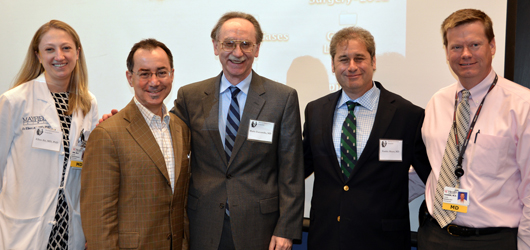
Photo by Tonya Hines / Mayfield Clinic.
Underutilized opportunities in epilepsy surgery and a changing landscape in cerebrovascular surgery were the subjects of presentations by Fredric Meyer, MD, the distinguished Mayfield Lecturer at the Mayfield Neuroscience Symposium Friday at the University of Cincinnati College of Medicine. Dr. Meyer is Chair of the Department of Neurologic Surgery and Neuroregenerative Medicine at the Mayo Clinic and the Alfred Uihlein Family Professor of Neurosurgery. The annual symposium is hosted by the Mayfield Clinic and the UC Department of Neurosurgery.
Dr. Meyer, the 32nd Mayfield Lecturer, delivered his presentations to a roomful of established physicians and medical residents who are still in training. He was introduced by Mario Zuccarello, MD, Chairman of the UC Department of Neurosurgery and the Frank H. Mayfield Chair.
Fredric Meyer, MD
In the arena of cerebrovascular neurosurgery, which includes the treatment of brain aneurysms, arteriovenous malformations and blocked arteries, the field is moving quickly in the direction of utilizing less invasive approaches, including endovascular and radiation treatment paradigms, Dr. Meyer said. This means far fewer cases in which neurosurgeons open the skull to make repairs and far more cases in which treatments involve maneuvering catheters containing coils, stents or glue through the arteries, from the groin to the brain, or focused stereotactic radiation. He said that across the country many aneurysms are now being successfully treated with endovascular procedures.
A study known as CREST concluded that stenting was as effective as surgery in the treatment of carotid disease, Dr. Meyer said. “Even at Mayo, which has outstanding surgical results superior to stenting, referrals for carotid surgery are down. Practice patterns have changed in the United States.” Dr. Meyer stated, however, that in good surgical hands, the risk of stroke is significantly less with surgery than with stenting, and that in his opinion carotid endarterectomy remains the gold standard.
On the topic of epilepsy, a brain disorder characterized by recurrent electrical disturbances, or seizures, Dr. Meyer urged physicians to seek out patients who can benefit from epilepsy surgery and to intervene early to reduce co-morbidities from chronic, uncontrolled seizures and to reduce the risk of seizure-related death from cardiac arrhythmias or aspiration. “Neurosurgery can make a significant impact on the quality of life of those who suffer from epilepsy,” he said.
He noted that one million Americans suffer from “partial” epilepsy, a condition in which the seizure emanates from a single spot in the brain, and that 45 percent of these patients have seizures that are not controlled by medication. “This is a huge population that we could potentially help surgically,” he said.
The key to successful epilepsy surgery is a collaborative program that includes epileptologists – neurologists who specialize in epilepsy, he said.
Treating patients with “generalized” seizures, which spread throughout the brain, is more difficult, Dr. Meyer said. Vagus nerve stimulation, which involves implanting a pacemaker-like device that produces electrical signals to prevent seizures, is helpful in 45 percent of patients treated. The procedure is expensive, with the device alone costing about $25,000.
Looking to the future, Dr. Meyer discussed potential new treatments for patients with uncontrolled seizures, including clinical trials of deep brain surgery and a device that shocks the brain if a seizure is detected.
Researchers are also incorporating micro electrodes into standard brain-mapping grids, he said. “We are finding that there are microbursts in the seizure zones – super rapid firing of 300 megahertz. If we can understand this, perhaps we can find the microcenters of destructive neurons and perform more tightly focused surgeries.”
— Cindy Starr